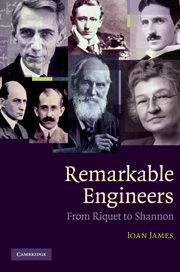Book contents
- Frontmatter
- Contents
- Preface
- Prologue
- 1 From Riquet to Watt
- 2 From Jessop to Marc Isambard Brunel
- 3 From Trevithick to Sadi Carnot
- 4 From Henry to Bazalgette
- 5 From Eads to Bell
- 6 From Braun to Hertz
- 7 From Diesel to Marconi
- 8 From Pal'chinskii to Zworykin
- 9 From Gabor to Shannon
- Epilogue
- Bibliography
- Credits
- Image credits
3 - From Trevithick to Sadi Carnot
Published online by Cambridge University Press: 17 December 2010
- Frontmatter
- Contents
- Preface
- Prologue
- 1 From Riquet to Watt
- 2 From Jessop to Marc Isambard Brunel
- 3 From Trevithick to Sadi Carnot
- 4 From Henry to Bazalgette
- 5 From Eads to Bell
- 6 From Braun to Hertz
- 7 From Diesel to Marconi
- 8 From Pal'chinskii to Zworykin
- 9 From Gabor to Shannon
- Epilogue
- Bibliography
- Credits
- Image credits
Summary
RICHARD TREVITHICK (1771–1833)
Throughout his life, the mechanical engineer Richard Trevithick was dogged by misfortune and never achieved worldly success, He was born at Pool in the parish of Illogan, Cornwall on 13 April 1771; he had four sisters, but no brothers. His father held the responsible position of manager at the important Dulcoath mine. While he was still a baby, the family moved to Penponds, just outside Camborne, where he went to school and learned the three R's. He grew up into an immensely strong young man, capable of lifting heavier weights than anyone else around. While still quite young he was appointed engineer, responsible for erecting and servicing the steam engines that pumped out water from the pits. In those days, the alternative to the Newcomen engine was the one supplied by the firm of Boulton and Watt.
In 1797, Trevithick's father died and his 26-year-old son became sufficiently well-off to marry. His bride was Jane Harvey, daughter of a local businessman. A woman of strong character who spared him domestic worries, she stood by him through thick and thin, despite the fact that with him work took precedence over family life. Trevithick was convinced of the need to increase the efficiency of steam engines to cope with the increasing depth of the pits but, like many others, was held back by Watt's master patent, covering every conceivable innovation, and Watt was opposed to the use of steam at much more than atmospheric pressure.
- Type
- Chapter
- Information
- Remarkable EngineersFrom Riquet to Shannon, pp. 33 - 56Publisher: Cambridge University PressPrint publication year: 2010



